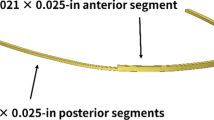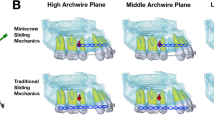Abstract
Aim
The purpose of this study is to compare the effects of different wire size reverse closing loop and retraction forces in canine tooth distalization using the finite element analysis method.
Materials and methods
Maxillary alveolar bone, maxillary first molar, second premolar and canine teeth were constructed in three dimensions along with their periodontal ligaments and standard edgewise brackets of 0.022 inch and stainless-steel reverse closing loop of 0.016 × 0.022 inch and 0.019 × 0.025 inch were designed. Force of 0.98 N and 1.96 N were applied to the arch wire from the posterior region of the molar tooth in the distal direction for activating the reverse closing loop. The stress distribution and displacement of the maxillary canine tooth were performed using the three-dimensional finite element analysis method.
Results
The maximum deformation on the canine tooth was higher in the x‑, y‑, and z‑axes in both arch wires with 1.96 N force activation. Moreover, 1.96 N caused more stress on the canine tooth in both arch wires compared to the application of 0.98 N. In terms of von Mises stress distribution on alveolar bones, the amount of stress was higher during the application of 1.96 N than the application of 0.98 N.
Conclusion
The finite element method is a reliable instrument which allows the effects of biomechanics applied in orthodontics to be evaluated. The finite element analysis method precisely predicted the mechanical effects of reverse closing loop of different wire sizes and different retraction forces.
Zusammenfassung
Ziel
Ziel der vorliegenden Studie war es, die Auswirkungen unterschiedlicher Bogendimensionen auf die Retraktionskräfte von Reverse-Closing-Loops mittels Finite-Elemente-Analyse zu vergleichen.
Material und Methoden
Alveolarknochen des Oberkiefers, erster oberer Molar, zweiter oberer Prämolar und obere Eckzähne wurden dreidimensional mit Paradontalligamenten und Standard Edgewise Brackets (22er Slotsystem) und Edelstahl Reverse Closing Loops (0,016 × 0,022 Zoll und 0,019 × 0,025 Zoll) konstruiert. Auf den Bogendraht wurden von der Molarenregion aus in distaler Richtung Kräfte von 0,98 N und 1,96 N aufgebracht, um den Reverse-Closing-Loop zu aktivieren. Die Spannungsverteilung und -verschiebung des oberen Eckzahnes wurde mit der dreidimensionalen Finite-Elemente-Methode evaluiert.
Ergebnisse
Die maximale Verformung am Eckzahn war in der x‑, y‑ und z‑Achse bei beiden Bogendimensionen nach 1,96-N-Aktivierung erhöht. Darüber hinaus verursachte die Anwendung von 1,96 N bei beiden Bogendimensionen eine höhere Belastung des Eckzahnes als die Kraftapplikation von 0,98 N. In Bezug auf die Von-Mises-Spannungsverteilung auf den Alveolarknochen war die Belastung bei der Anwendung von 1,96 N höher als bei der Anwendung von 0,98 N.
Fazit
Die Finite-Elemente-Methode ist eine zuverlässige Methodik, mit dem sich die Auswirkungen orthodontisch induzierter Kraftsysteme bewerten lassen. Mit dem Finite-Elemente-Modell ließen sich die Effekte verschiedener Drahtdimensionen auf die Retraktionskräfte von bei Reverse-Closing-Loops präzise vorhersagen.






Similar content being viewed by others
References
Canales C, Larson M, Grauer D, Sheats R, Stevens C, Ko CC (2013) A novel biomechanical model assessing continuous orthodontic archwire activation. Am J Orthod Dentofacial Orthop 143:281–290
Chang YI, Shin SJ, Baek SH (2004) Three-dimensional finite element analysis in distal en masse movement of the maxillary dentition with the multiloop edgewise archwire. Eur J Orthod 26:339–345
Heo GH, Cha GS, Ju JW (2000) Finite element modeling and mechanical analysis of orthodontics. Trans Korean Soc Mech Eng A 24:907–915
Holberg C, Winterhalder P, Holberg N, Rudzki-Janson I, Wichelhaus A (2013) Direct versus indirect loading of orthodontic miniscrew implants-an FEM analysis. Clin Oral Investig 17:1821–1827
Kim MJ, Park JH, Kojima Y, Tai K, Chae JM (2018) A finite element analysis of the optimal bending angles in a running loop for mesial translation of a mandibular molar using indirect skeletal anchorage. Orthod Craniofac Res 21:63–70
Ko CC, Rocha EP, Larson M (2012) Past, present, and future of finite element analysis in dental biomechanics. In: Moratal D (ed) Finite element analysis—from biomedical applications to industrial developments. Intech Open, London
Macginnis M, Chu H, Youssef G, Wu KW, Machado AW, Moon W (2014) The effects of micro-implant assisted rapid palatal expansion (MARPE) on the nasomaxillary complex—a finite element method (FEM) analysis. Prog Orthod 15:52
Nienkemper M, Wilmes B, Pauls A, Drescher D (2014) Mini-implant stability at the initial healing period: A clinical pilot study. Angle Orthod 84:127–133
Papageorgiou SN, Keilig L, Vandevska-Radunovi CV, Eliades T, Bourauel C (2017) Torque differences due to the material variation of the orthodontic appliance: A finite element study. Prog Orthod 18:6
Park HS, Bae SM, Kyung HM, Sung JH (2001) Micro-implant anchorage for treatment of skeletal Class I bialveolar protrusion. J Clin Orthod 35:417–422
Perillo L, Jamilian A, Shafieyoon A, Karimi H, Cozzani M (2015) Finite element analysis of miniscrew placement in mandibular alveolar bone with varied angulations. Eur J Orthod 37:56–59
Sung EH, Kim SJ, Chun YS, Park YC, Yu HS, Lee KJ (2015) Distalization pattern of whole maxillary dentition according to force application points. Korean J Orthod 45:20–28
Techalertpaisarn P, Versluis A (2016) T‑loop force system with and without vertical step using finite element analysis. Angle Orthod 86:372–379
Xue J, Ye N, Yang X, Wang S, Wang J, Wang Y, Li J, Mi C, Lai W (2014) Finite element analysis of rapid canine retraction through reducing resistance and distraction. J Appl Oral Sci 22:52–60
Funding
The authors have no financial relationship with the organization that sponsored the research.
Author information
Authors and Affiliations
Corresponding author
Ethics declarations
Conflict of interest
S.K. Buyuk, M.S. Guler and M.L. Bekci declare that they have no competing interests.
Rights and permissions
About this article
Cite this article
Buyuk, S.K., Guler, M.S. & Bekci, M.L. Effect of arch wire size on orthodontic reverse closing loop and retraction force in canine tooth distalization. J Orofac Orthop 80, 17–24 (2019). https://doi.org/10.1007/s00056-018-0161-1
Received:
Accepted:
Published:
Issue Date:
DOI: https://doi.org/10.1007/s00056-018-0161-1




